Lecture 4: Gram negative bacteria curved rod
1/28
There's no tags or description
Looks like no tags are added yet.
Name | Mastery | Learn | Test | Matching | Spaced |
|---|
No study sessions yet.
29 Terms
Gram - bacilli groups
1.Straight (enteric) - Escherichia and salmonella
2.Curved - Helicobacter and Vibrio

Helicobacter pylori characteristics
Curved (helical) rod shaped, gram -, slow growing, and is acid resistance so it’s able to colonize gastric mucosa and the stomach

H. pylori Transmission
Spread person-to-person by saliva or consuming food or water contaminated with this bacteria (oral-oral or fecal-oral)
H. pylori Conditions
Survives harsh acidic conditions pH=2 (acid resistant) and cell damage
H. pylori Virulence Factors
Acid neutralization (urease)
Motility (flagella)
Adherence factors (colonization of mucus layer)
Exotoxin production (VacA, CagA)
H. Pylori Diseases
Gastritis, Peptic ulcer, and Stomach cancer
Infections are asymptomatic
H. Pylori Gastritis
irritation and inflammation of the stomach lining
H. Pylori Peptic Ulcer
ulcerative sores in the lining of stomach, SI, &/or esophagus
H. Pylori Stomach cancer
after years of untreated acid irritation/erosion of gastric mucosa (less common than gastritis/ulcers); result of chronic infection
Peptic Ulcer Symptoms
Can be asymptomatic or symptomatic
Symptoms: abdomen pain, bloating, low appetite, dark color stools, and ulcer bleeding
H. Pylori Diagnosis
Using breath (C13-urea test), stool, or blood test.
Examination by endoscopy and/or gastric biopsy
H. Pylori Treatment
Curable with antibiotic therapy at early stages
– Acid blockers (Proton pump inhibitors) aid healing by reducing stomach acid
H. Pylori Prevention
Patients should do therapy (Abx + PPI), good hygiene with washing hands and safe food handling, and lifestyle changes can help recovery

Vibrio Cholerae Characteristics
Highly motile, comma-shaped, Gram - with a single flagellum, non invasive human pathogen
Cholera
Acute diarrheal disease of humans caused by infection of intestinal tract, asymptomatic, and severe fluid and electrolyte loss
Vibrio Cholerae Found
free living or attached to algae, plankton, or shellfish in aquatic environment like coastal waters
Vibrio Cholerae Transmission
By drinking contaminated water and food, linked to lack of water sanitation and access hygiene
Vibrio Cholerae Infects
humans intestines and causes potentially lethal watery diarrhea
Vibrio Cholerae Epidemiology
Endemic infections (47 countries today): Coastal communities are hot spots
Epidemic (pandemic potential) outbreaks (40 countries today): less predictable, can occur inland
Vibrio Cholerae Major virulence factors
Toxin-Coregulated Pilus (TCP)
Cholera Toxin (CT)
Toxin-Coregulated Pilus (TCP)
Critical for colonization of the host gut mucosal layer
Cholera Toxin (CT) – potent AB exotoxin
Binds to receptors on intestinal epithelial cells which causes a build up of ions in intestinal lumen and draws water from cells and tissue via osmosis
rice water stools
the profuse, watery diarrhea, often pale and cloudy with mucus, that is a hallmark symptom of cholera
Fatal dehydration and hypovolemic shock
Caused by severe fluid and electrolyte loss by action of cholera toxin
Cholera diagnosis
Symptoms and fecal culture
Cholera Treatment
Treated with oral rehydration solution, a prepackaged mixture of sugar and salts mixed with water
Cholera Prevention
Proper sewage treatment and safe water management
Travelers to endemic areas:
Should only eat or drink items that have been boiled, cooked, or peeled
VaxchoraTM (approved in 2016); 3- 6 months protection
H. pylori ulcers summary
Chronic, infects stomach (gastritis), causes stomach pain by weakening mucus layer of stomach, spread person to person via fecal-oral or oral-oral
Cholera summary
Acute, infects small intestine by exotoxin that secretes a lot electrolytes and fluid, causes diarrhea, and spread fecal-oral